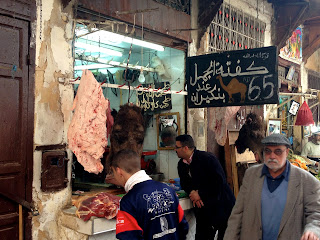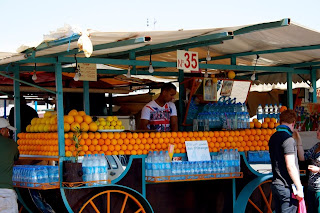Let's start with food. Generally, it was awesome. There were only two drawbacks:
- Moroccans eat very late dinners, often after 9 or 10pm. To supplement, they usually take a small snack in the mid-afternoon, but every day I was starving by dinner time.
- You have to be very careful what you eat. Street food can be risky, so always proceed with caution. Our homestay food in the city was fine, fortunately (the villages, which I'll address later, were another story). But some students were not so lucky and got mildly sick anyways. The drinking water in the city was supposedly okay too, but I never risked it. And as we all were warned many times, once you leave the city of Rabat, never drink the water.
Back to the good stuff though: Morocco is known for couscous and that reputation is well-earned. In Rabat, Friday is the day when every family cooks couscous for lunch and it's delicious. However, Moroccans eat all food with their hands (actually only the right hand is polite to use). And believe me, shoveling grainy couscous into your palm isn't easy. Our host mom was a pro, but she was nice enough to offer Katie and I spoons after we struggled for a good five minutes.
Here's another typical Moroccan meal called tagine chicken - it's named for the special cone-shaped earthenware pot in which its cooked.
Another Moroccan staple? Mint tea. It's very sweet and people drink it multiple times a day. I am now officially an addict; I even brought a couple of bags back to Switzerland with me.
Orange juice is also a pretty big deal in Morocco because it's incredibly fresh. You can buy it easily on the street for 5 dirhams (about 60 cents)
Sorry for all the pictures of food, but we ate a lot every day. Moroccans famously force-feed their guests; in fact the first arabic word I learned was "Kuli!" which means "eat more!" I very quickly learned the appropriate response though, which is "Shookran! Saffit! Sbet!" or "Thanks! That's enough! Full!" However, unless you repeat those words several times, they will not stop feeding you.
And, although we were fed very well in our homestay, it was also a relief to know that we could buy food on the street when we wanted, without it costing an arm in a leg. The Moroccan unit of currency is the dirham, which is 8.50 to the dollar - such a nice change from Switzerland! Needless to say, I wound up doing plenty of shopping in the souks (markets).
 |
| The souk in Rabat |
Shopping is pretty hectic, but also immensely gratifying. You have to haggle for everything - even the one time we bought toilet paper! Fortunately the shopkeepers all speak English or French because they're accustomed to tourists. Merchants will try to spike the price if you're obviously a tourist, but even a "high" price in the souk sounds fantastic to me after shopping in Switzerland!
And there were all kinds of merchandise available: slippers, rugs, pottery, leather goods, scarves, spices, teas, fresh fish, baby turtles, camel meat, anything you could imagine.

 |
| Why yes, that is a decapitated camel head hanging from a hook |
The souks were so full of life, as was the entire city. It's very different from Switzerland, where people mind their own business and keep to themselves. In Morocco, shopkeepers call out to you and try to literally corral you into their stores. Men also cat-call women in the streets, which is a little disconcerting at first. For some reason they always yelled "Teacher!" at me, so I must even look more intellectual than I thought. But overall street life is noisy, bustling, chaotic and amazing.
The cat calls didn't bother me much, but they did really get to some of the other students, especially those of different races. A couple of Asian girls in my program got pretty sick of men following them down the street yelling "Nihao!" "Konichiwa!" or "Jackie Chan!" People would start singing "Gangham Style" whenever they passed by as well. Another girl, who's African American, was frequently called "Oprah" or "Bob Marley."
There was another type of cat-call in the streets though: from real cats! Strays were all over the city. They were like squirrels practically. But they looked pretty mangy and sick, so although I really wanted to, I never pet them (very difficult for a cat lover like me).
 |
| Cats snoozing on rugs in the souk |
The last cultural experience worth noting: hammams. I thought I was mentally equipped to go into one of these bathhouses, but it wound up being a lot more than any of us Americans had bargained for.
The hammams are separated by gender; customers pay 10 dirhams to go in. For newcomers, it's recommended to also pay an extra 50 dirhams for a professional to help scrub you down.
My host mom walked me, my roommate, and another student over to the building, as we toted buckets full of soaps, shower shoes and towels along with us. Once we got in the door, she immediately ordered us all to strip - and if one of us was being too modest or slow in disrobing, she would literally rip the clothing off of our bodies! In the end, we were allowed to wear just a set of bottoms inside (although some local women choose to go without even that!)
The scrub down was just as bizarre as you might imagine - I'll spare you the graphic details though. We got to use special black soaps and sandpaper-like scrubbing mitts that took layers of dead skin off of our bodies. The women in there often clucked at us and shook their heads, as if we were babies who didn't even now how to wash themselves. But, after being rubbed raw, shampooed, and doused in water, we left feeling cleaner (and more violated) than we had ever felt in our lives.
Sorry this is such a long post - I had a lot to say, it seems! Two more Morocco posts to come: one on my excursions to Fes/Casablanca and one on life in the rural villages.










No comments:
Post a Comment